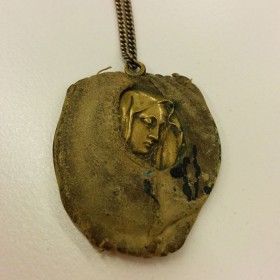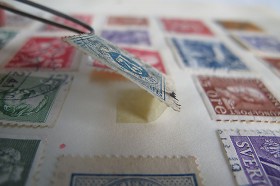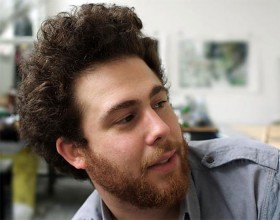An extraordinary gift

Medallion with the image of a saint © Jewish Museum Berlin, photo: Jörg Waßmer, gift of Fred Kranz
Last week, museum benefactor Fred Kranz accepted our invitation to participate in two workshops in our archives. He met with two classes of schoolchildren, one from Döbeln in Saxony and the other from Berlin’s Tegel district. It was the fifth time in recent years that Mr. Kranz – who was born in Berlin in 1938 – came back from the USA to speak to students and their parents about his life. The Kranz family, which consisted of Fred and his parents, survived the war living on a farm that belonged to a former employee of his father, in the village of Kallinchen on Motzener See (Lake Motzen) in Brandenburg.
In 2004, Fred Kranz donated a collection of documents and photographs to the museum that provide an impressive record of Jewish life in the years immediately following the war. During his most recent visit, he gave us a very special – a truly unique – object. Here is the story of this piece, in his words: → continue reading

A stamp with a loose paper hinge © Jewish Museum Berlin. Donated by Kurt W. Roberg, photo: Kirsten Meyer
Kurt Roberg (*1924) made a bequest to the Jewish Museum Berlin this year, which comprised among other things a stamp-album—one of the very few items in Roberg’s possession when he fled Berlin for Lisbon then New York in May 1941. Jewish emigrés were forbidden to take their belongings with them out of Germany so Roberg came to see the album as a symbol of his personal triumph over the National Socialist dictatorship.
It is a simple folder containing → continue reading

David Moses © photo: B.Gruhl
The construction and the fall of the Berlin Wall have occupied two generations of artists in the Moses family: in 1963/64 Manfred Heinz Moses created “The Balcony,” an etching on which, fifty years down the line, his grandson David Moses was to base a woodcut and polychrome etching. The latter works are likewise called “The Balcony” and they number among the unique pieces developed by seven artists resident in Berlin for the art vending machine on display in our permanent exhibition. A total stock of 1,400 artworks has been sold since early summer.
Grandpa Moses created his etching when still reeling from the shock of a trip to Berlin shortly after the Wall was built. It shows → continue reading


